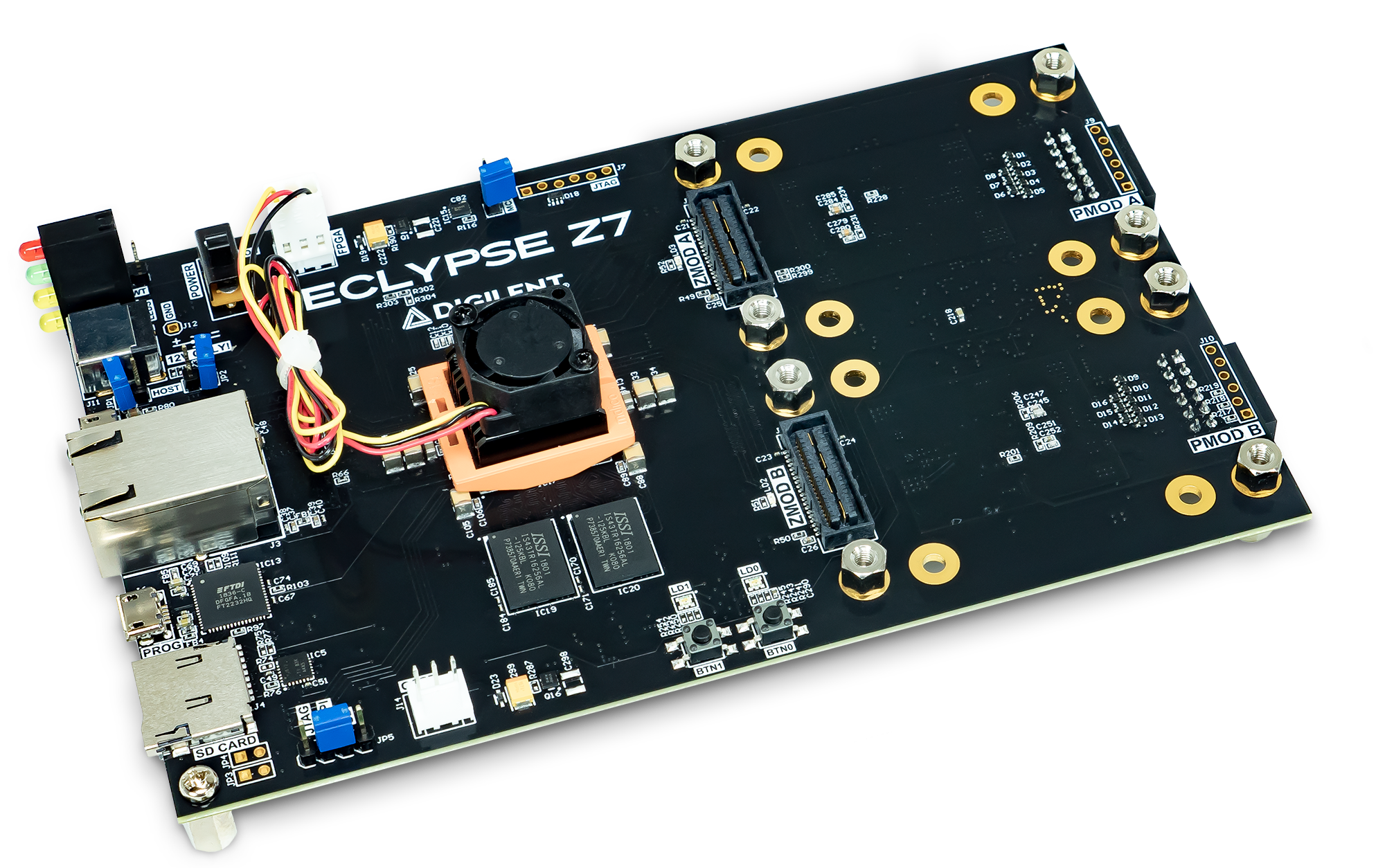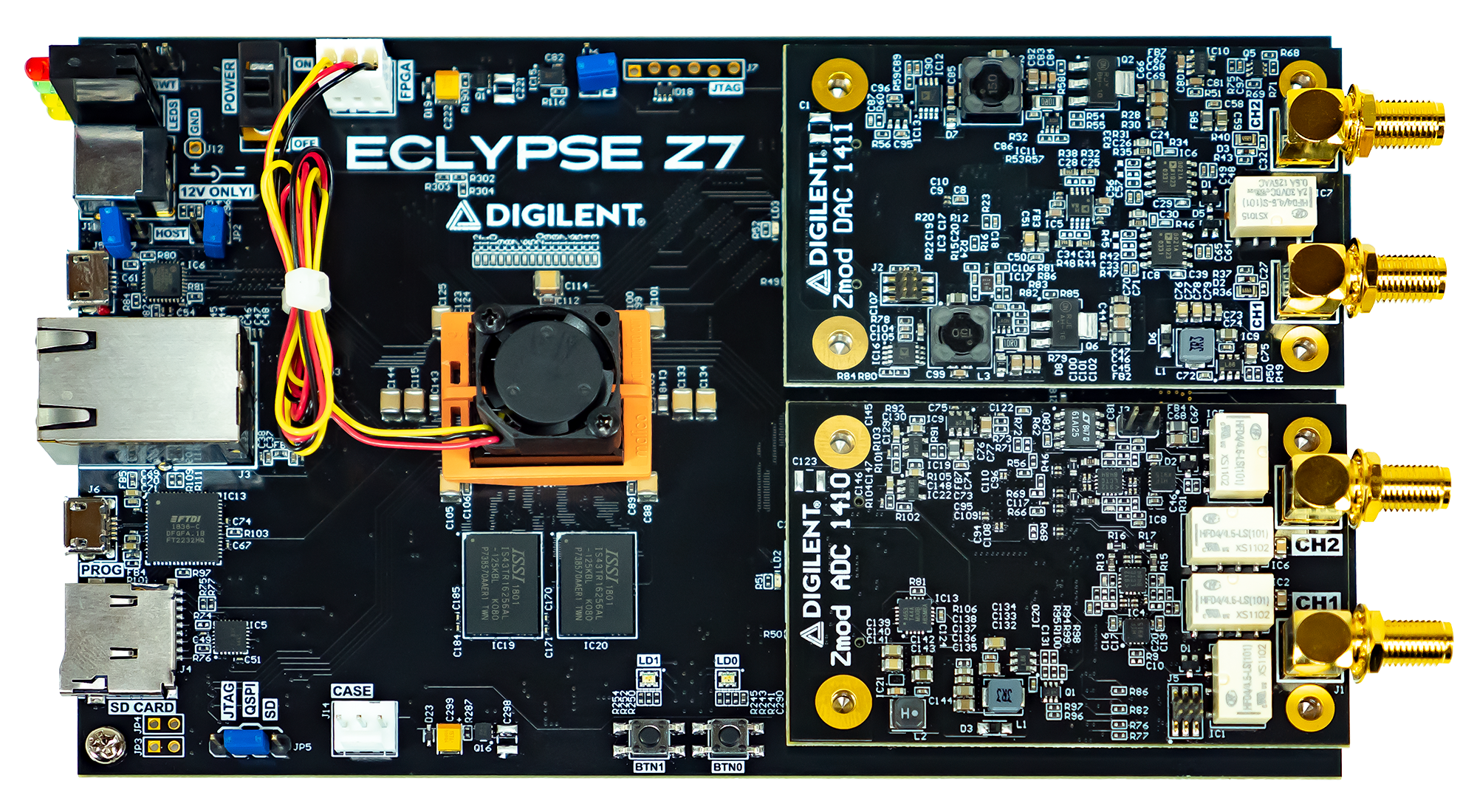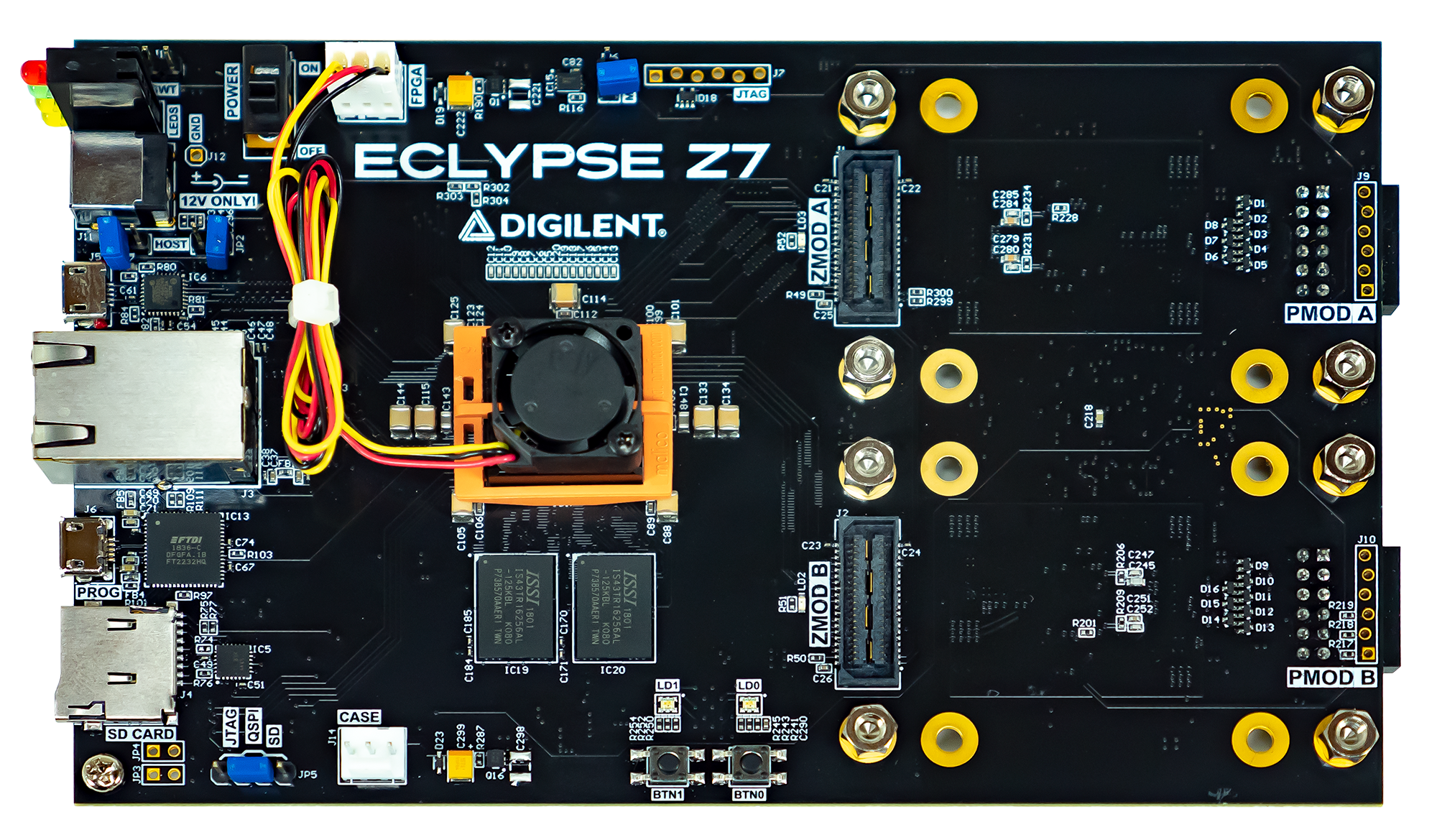Eclypse Z7
- Full support for Vivado, including tool integration, example projects and tutorials
- Out-of-the-box Petalinux support, including example projects and tutorials
- 667MHz dual-core Cortex-A9 processor with tightly integrated Xilinx FPGA
- 2 SYZYGY Standard Interfaces for high-speed data transfer in modular systems
- 2 Pmod connectors for additional system modularity
- 1 GB DDR3L with 32-bit bus @ 1066 MT/s
- USB and Ethernet connectivity
- Programmable from JTAG, Quad-SPI flash, and microSD card
4 PLLs
4 MMCMs
125 MHz external clock
USB-JTAG programmer
USB micro-AB Host/Device/OTG port
Automatically negotiated on board bring-up
The Eclypse Z7 is a powerful prototyping platform, featuring Xilinx's Zynq-7000 APSoC. A SYZYGY™ 1) compatible carrier board, it features two SYZYGY™ interface connectors, enabling high speed modular systems.
Eclypse is designed to enable high speed analog data capture and analysis. It is a platform for research and rapid prototyping of test and measurement applications, potentially including software-defined radio, ultrasound, other medical devices, and much more. As a host board for Zmods, applications for the Eclypse can vary significantly between system configurations.
This page is the resource center for the Eclypse Z7, where you will find all of Digilent’s support materials and documentation for the Eclypse, including fully open and customizable hardware designs, baremetal software examples, and Linux images.
Getting Started
Documentation
-
- The Digilent Eclypse Utility is a command line tool available within Digilent-provided Linux system images that allows the user to communicate with the Eclypse PMCU.
Peripherals
- The Eclypse Z7 is compatible with Digilent Zmods, as well as other modules that conform to Opal Kelly's SYZYGY Standard Specification. A list of Digilent Zmods can be found through their start page, linked above.
- The Eclypse Z7 is compatible with modules that conform to Digilent's Pmod™ Specification, including Digilent's line of Pmods.
Development Environments
Important: Make sure that you install the version of Vivado required by demo materials you want to use.
Vivado and Vitis
- Installing Vivado, Vitis, and Digilent Board Files covers first-time installation of Vivado, Vitis, and board files to support Vivado IPI flows for Digilent boards.
Petalinux
- Petalinux is a tool created by Xilinx, used for the creation and modification of Linux images for Xilinx chips, including the Zynq-7000.
Xilinx's Petalinux Tools Reference Guide (UG1144) covers installation and usage of Petalinux. Chapter 2 discusses the installation process.
Note: For Windows users, Digilent recommends the use of either a dual-boot Linux setup or virtual machine that fits the requirements specified in UG1144, linked above.
Note: Xilinx software tools are not available for download in some countries. Prior to purchasing the Eclypse Z7, please check the supporting software's availability, as it is required for the board's use.
Example Projects
- Using the Zmod Scope 1410-105 with the Zmod Library and Eclypse Z7 is a software demo (Baremetal and PetaLinux) that captures data from the ADC and writes it out to a file (in PetaLinux) and standard out. This demo uses the Zmod Library and the initial release of the Zmod IPs. Zmod Scope variants other than the 1410-105 are not supported.
- Using the Zmod AWG with the Zmod Library and Eclypse Z7 is a software demo (Baremetal and PetaLinux) that outputs a ramp waveform through one of the channels of the Zmod AWG. This demo uses the Zmod Library and the initial release of the Zmod IPs.
- Eclypse Z7 Low-Level Low-Pass Filter Demo is a hardware-only demo that captures data from a Zmod Scope, passes it through a FIR filter in the Zynq PL, and outputs it through a Zmod AWG. The latest release of the Zmod IPs is used, and all variants of the Zmod Scope are supported.
- The Eclypse Z7 Out of Box Demo is programmed into flash memory during manufacturing of the Eclypse. Baremetal software is used to cycle the RGB LEDs and report button states over UART.
Support for Zmods
As of the time of writing, two different versions of the Zmod IPs used to provide a hardware interface from the Zynq PL to the Zmods exist. These two versions have different pros and cons. In short, at the time of writing, the latest release supports all of the variants of the Zmod Scope but does not yet support Petalinux or Baremetal software projects, while the initial release fully supports software, but does not support variants of the Zmod Scope other than the 1410-105.
Latest Release
The Zmod AWG 1411 Controller and Zmod Scope Controller make up the second release of the low-level controller IP. No compatible software libraries are available at the time of writing. The Zmod Digitizer is supported by the Zmod Digitizer Controller IP.
For a hardware-only project demonstrating their use, see the Eclypse Z7 Low-Level Low-Pass Filter Demo.
Initial Release
Zmod AWG
The initial release of demos for the Eclypse and Zmod AWG used the Zmod Library to control the Zmod AWG through the Zmod DAC 1411 AXI Adapter and Zmod DAC 1411 Low Level Controller IPs.
Using the Zmod AWG with the Zmod Library and Eclypse Z7 is a software demo (Baremetal and PetaLinux) that outputs a ramp waveform through one of the channels of the Zmod AWG. This demo uses the Zmod Library and the initial release of the Zmod IPs.
Zmod Scope
The initial release of demos for the Eclypse and Zmod Scope used the Zmod Library to control the Zmod Scope through the Zmod ADC1410 AXI Adapter and Zmod ADC 1410 Low Level Controller IPs. These IPs are only compatible with the Zmod Scope 1410-105 (formerly the Zmod ADC 1410).
Using the Zmod Scope 1410-105 with the Zmod Library and Eclypse Z7 is a software demo (Baremetal and PetaLinux) that performs an immediate capture of 10 μs of data from channel one of the Zmod Scope and writes it to standard out and (in Linux) a file. This demo uses the Zmod Library and the initial release of the Zmod IPs.
Additional Tutorials and Guides for the Eclypse Platform
-
- The Eclypse is now supported by Digilent's WaveForms software. By setting it up with a boot image on an SD card, you can use this mature software in conjunction with the Eclypse as a fully-featured Mixed-Signal Oscilloscope and Arbitrary Waveform Generator.
-
- The documentation of the Zmod Base Library includes the steps necessary to run one of several Digilent-provided software examples on the Eclypse Platform.
- Note: The Zmod Library is only compatible with the initial release of the Zmod IPs, as described above.
-
- This tutorial covers the creation of a basic baremetal application that blinks an LED. Vivado IPI is used to design the system and Vitis is used to develop the application.
-
- This tutorial covers the addition of a hierarchical block supporting a specific peripheral, whether Pmod or Zmod, to an existing IPI design, adding required library source files to a baremetal Xilinx SDK application project, and running an example on the board.
-
- This tutorial covers the steps necessary to configure and build the Eclypse Z7 Petalinux project to support a new Zmod configuration.
Additional Resources
-
- VAXEL-EZ boosts the productivity of algorithm verification processes on Digilent FPGA boards. The package includes a set of utility software that runs on Windows to facilitate tasks ranging from automation of FPGA synthesis to execution of tests. With VAXEL-EZ, no FPGA expertise is needed to take full advantage of the Digilent FPGA boards.




